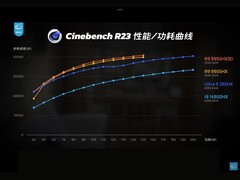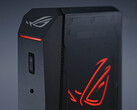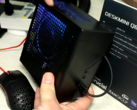A new Cinebench R23 benchmark comparison shared by Chinese YouTuber Geekerwan has sparked a wave of discussion across Reddit’s r/GamingLaptops community, after user u/Aggravating_Match298 posted the results, and not just for the numbers. The chart compares power draw versus multi-core performance for AMD’s Ryzen 9 9955HX3D, Ryzen 9 9955HX, Intel’s Core Ultra 9 285HX, and the older Intel Core i9-14900HX.
In the 40–100W range, AMD’s 9955HX3D leads with significantly better performance-per-watt, as per the graph. The non-3D variant follows closely, highlighting the architectural gains AMD has made with its Fire Range platform. Intel’s Ultra 9 285HX catches up only at higher power levels beyond 130W, while the 14900HX trails across the board.
But beyond the benchmark curve, the Reddit discussion points to some real-world friction. Several users flagged OEM reluctance to adopt AMD’s new chips in mainstream models. “Almost no high-end gaming laptops are using AMD despite better efficiency,” one user said.
Some users on Reddit also raised concerns about thermal design choices. They claim that Dell may be reusing Intel-based cooling layouts in their AMD laptop variants. In one example, a user reported that the AMD version of a Dell machine lacked vapor chamber cooling and used a thick shim to make contact with the chiplets, allegedly because the heatsink was originally designed for an Intel CPU layout.
This, they suggest, could lead to less efficient thermal performance. However, this design choice has not been confirmed by Dell or any other official source and remains anecdotal.
Still, there’s no denying the appeal. Geekerwan's raph, now widely shared across Reddit and other platforms, positions AMD’s 9955HX3D as a strong contender for creators and gamers who prioritize multi-threaded performance with relatively efficient power draw.
Yet users were quick to point out a key limitation, availability. Only a handful of high-end models from MSI, ASUS, and XMG currently feature the chip, and broader OEM adoption appears slow. Some speculate that limited supply and Intel’s stronger presence in OEM pipelines are partly to blame.
Whether OEMs ramp up support for AMD’s Fire Range or continue to favor Intel’s more widely adopted platforms remains to be seen. For now, Reddit discussions suggest that while AMD appears to lead in performance per watt, availability and OEM adoption continue to tilt in Intel’s favor.
Just in case you're interested, Notebookcheck did a 9955HX3D review of its own not so long ago.


















